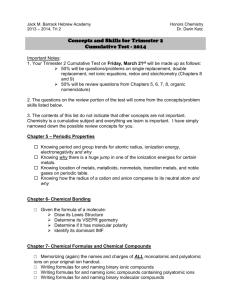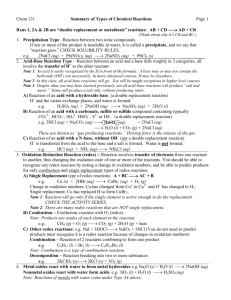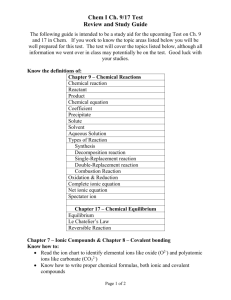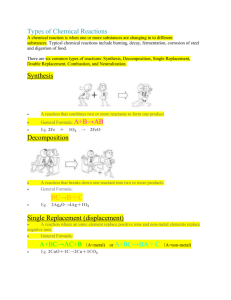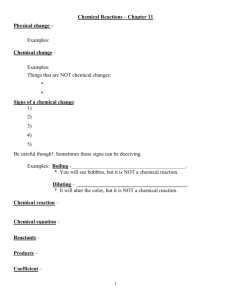Dowd AP Chemistry 10-08-12 Reaction Types
advertisement
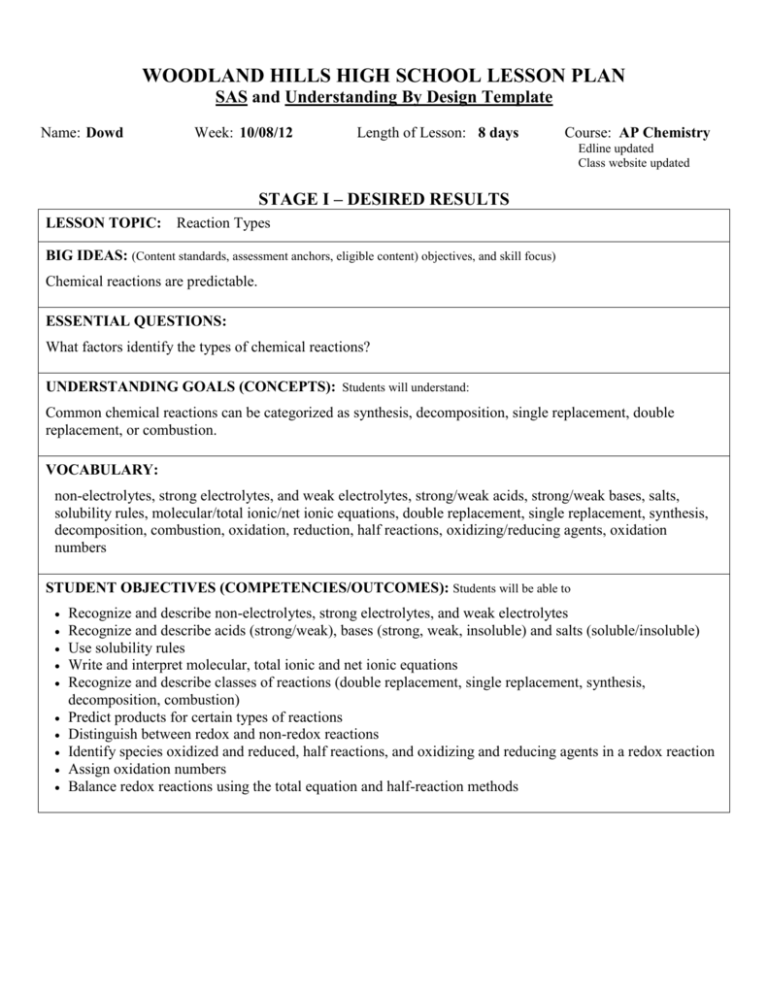
WOODLAND HILLS HIGH SCHOOL LESSON PLAN SAS and Understanding By Design Template Name: Dowd Week: 10/08/12 Length of Lesson: 8 days Course: AP Chemistry Edline updated Class website updated STAGE I – DESIRED RESULTS LESSON TOPIC: Reaction Types BIG IDEAS: (Content standards, assessment anchors, eligible content) objectives, and skill focus) Chemical reactions are predictable. ESSENTIAL QUESTIONS: What factors identify the types of chemical reactions? UNDERSTANDING GOALS (CONCEPTS): Students will understand: Common chemical reactions can be categorized as synthesis, decomposition, single replacement, double replacement, or combustion. VOCABULARY: non-electrolytes, strong electrolytes, and weak electrolytes, strong/weak acids, strong/weak bases, salts, solubility rules, molecular/total ionic/net ionic equations, double replacement, single replacement, synthesis, decomposition, combustion, oxidation, reduction, half reactions, oxidizing/reducing agents, oxidation numbers STUDENT OBJECTIVES (COMPETENCIES/OUTCOMES): Students will be able to Recognize and describe non-electrolytes, strong electrolytes, and weak electrolytes Recognize and describe acids (strong/weak), bases (strong, weak, insoluble) and salts (soluble/insoluble) Use solubility rules Write and interpret molecular, total ionic and net ionic equations Recognize and describe classes of reactions (double replacement, single replacement, synthesis, decomposition, combustion) Predict products for certain types of reactions Distinguish between redox and non-redox reactions Identify species oxidized and reduced, half reactions, and oxidizing and reducing agents in a redox reaction Assign oxidation numbers Balance redox reactions using the total equation and half-reaction methods STAGE II – ASSESSMENT EVIDENCE PERFORMANCE TASK: FORMATIVE ASSESSMENTS: Class discussion Assignments Tests/Quizzes Laboratory experience Observation Notetaking Asking/Answering questions Performing Lab STAGE III – LEARNING PLAN INSTRUCTIONAL PROCEDURES: MATERIALS & RESOURCES: Explicit Instruction Overhead/Board Lab material/equipment Handouts Content Area Reading Presentation Discussion Modeling Demonstration Prelab INTERVENTIONS: Preferential seating Cooperative work Active Engagement Note-taking Partnering Cooperative Education Higher Level Thinking Scaffolding Build on prior knowledge Build vocabulary MINI LESSON: Reaction types: recognizing types and redox vs nonredox Single Replacement reactions: Metal/H and nonmetal types; predicting products, using activity series Ionic and net ionic equations; Intro & practice Double Replacement: intro & types, precipitation and solubility rules Double Replacement: Acid-Base Reactions; ID strong acids/bases; Neutralization with H2O/Gas formation Combination reactions; Decomposition reactions Intro to redox: terminology, oxidation numbers and rules Balancing redox eqns; Total equation method and half-reaction method Volumetric Analysis Expt: prelab, perform lab, analysis Reactions in Aqueous Solutions Expt: prelab, perform lab, analysis ASSIGNMENTS: A10. EOC 4: 21ad,25,27ab,29ab,84,93,94 (include SR & DR in 93,94) (Rxn types and SR/DR Rxns) A11. EOC 4: 31,33ac,35bc,40,41,44,90bc,91ab,95,98 (Acid – Base and DR Rxns) A12. EOC 4: 45bd,47bd,49bd,50,51,53,55(total),56 (total) & EOC 19: 27bd,29de,32ab,34ab (Redox)


